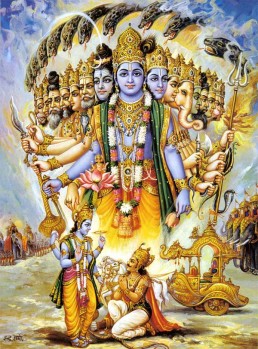Swami Chinmayananda
Swami Chinmayananda Commentary
A philosophy that comprehends the totality without fear or favour and is even true to its mission of seeking Truth, cannot afford to ignore the DESTRUCTIVE-aspect in nature. No creation is possible without being preceded by the process of destruction of its own existence as the raw material from which the created is produced. On the face of the Universe also, wherever there is “existence” it is nothing but a repetition of constant change, and change can be interpreted either in terms of constant-creation with regard to the MADE-PRODUCTS, or as a process of constant-destruction with regard to the RAW-MATERIAL that changed.
Thus, we see that in Hinduism, the daring Masters of the Aryan fold, while extolling the beauty of the Reality, indulged themselves in viewing It not only as the Omniscient-Creator, or as the Omnipotent-Sustainer, but also as the All-powerful-Devourer of all names and forms. This may look dreadful to those creeds that have not yet come to watch and analyse Life in its totality.
Arjuna’s words are significant. He does not see the Universal-Form itself devouring the names and forms. On the other hand, he observed that all names and forms “ENTER IN HASTE INTO THY MOUTH.” When we watch an ocean, we do not find the ocean ever rising up to absorb the waves, but the waves which have risen from the ocean, after a momentary play upon the surface, rush back to disappear into the very ocean. The multiplicity that has risen from the Totality, after its play upon the surface of Truth, must necessarily rush back in all hurry into the very Whole from which they had arisen.
Arjuna watches “ALL THE SONS OF DHRITARASHTRA, THE HOSTS OF KINGS, BHISHMA, DRONA, KARNA, THE SON OF A CHARIOTEER, ALONG WITH THE WARRIOR CHIEFTAINS OF OURS” entering precipitately into the yawning mouth of the Principle of Destruction in nature. This not only frightens Arjuna and unnerves him, but also gives him a confidence to look ahead — in spite of the fact that in numerical strength, in supplies, and in technicians, his own army was much inferior to the mighty forces of the Kurus. The Vision which he saw, was in fact a peep into the future. In the Vishwaroopa, when the Lord expresses Himself as the entire world of phenomena, a conception of oneness arises in which not only space shrinks, but even Time becomes an object-of-observation.
It is no wonder, therefore, that Arjuna saw in that picture THE PAST MERGING WITH THE PRESENT AND MOVING FORWARD TO MINGLE WITH THE ENTIRE FUTURE. When I have the entire Geeta-book before me, I can read either the preceding two pages or can skip over them and read the third page ahead or, according to my will and desire, continue reading this very same page. Similarly, when the whole Universe is brought at once within the compass of Arjuna’s vision, he could see herein at one gaze “ALL THE HERE AND THE THERE, AND THE EVERYWHERE” — so too THE PAST, THE PRESENT AND THE FUTURE. The modern scientists also have now come to realise and accept that Time and Space are one and the same, and they are each expressed in terms of the other.
The seekers of Truth, themselves truthful, were not all all afraid if their enquiry took them to the aspect of the terrible in the Truth. The world is a combination of the beautiful and the ugly, the good and the bad, the soft and the hard, the sweet and the bitter. God, the Lord, has Himself become all these, and therefore, no adoration of the Lord, or estimate of the Reality, will be complete, if, according to our taste, we recognise only the beautiful, the good, the soft, and the sweet aspects of Him. An unprejudiced and detached mind will have to recognise Him as the ugly and the bad, the hard and the bitter also. That philosophy alone is complete which points out that the Supreme is, in fact, in Its Absolute Nature, beyond all these qualities.
In a purely scientific approach, therefore, Arjuna is made to express all the details, even if they be blood-curdling and gruesome. No doubt, the Geeta has its own sense of realism. The mouth of death is described here with all faithfulness as “TERRIBLE WITH TUSKS,” “FEARFUL TO BEHOLD.”
HOW DO THEY ENTER THY MOUTH? ARJUNA SAYS:
Adi Sankara Commentary
Visanti, they enter; tvarmanah, rapidly, in great haste; into te, Your; vaktrani, mouths;-what kind of mouths?-bhayanakani, terrible; damstra-karalani, with cruel teeth. Besides, among these who have entered the mouths, kecit, some; samdrsyante, are see; vilagna, sticking, like meat eaten; dasanantaresu, in the gaps between the teeth; uttamangaih, with their heads; curnitaih, crushed. As to how they enter, he says:
The Bhagavad Gita with the commentary of Sri Sankaracharya – Translated by Alladi Mahadeva Sastry
Holy Geeta – Commentary by Swami Chinmayananda
The Bhagavad Gita by Eknath Easwaran – Best selling translation of the Bhagavad Gita
The Bhagavad Gita – Translation and Commentary by Swami Sivananda
Bhagavad Gita – Translation and Commentary by Bhaktivedanta Swami Prabupadha
Srimad Bhagavad Gita Chapter 11 – Verse 27 – 11.27 vaktrani te – All Bhagavad Gita (Geeta) Verses in Sanskrit, English, Transliteration, Word Meaning, Translation, Audio, Shankara Bhashya, Adi Sankaracharya Commentary and Links to Videos by Swami Chinmayananda and others – 11-27

